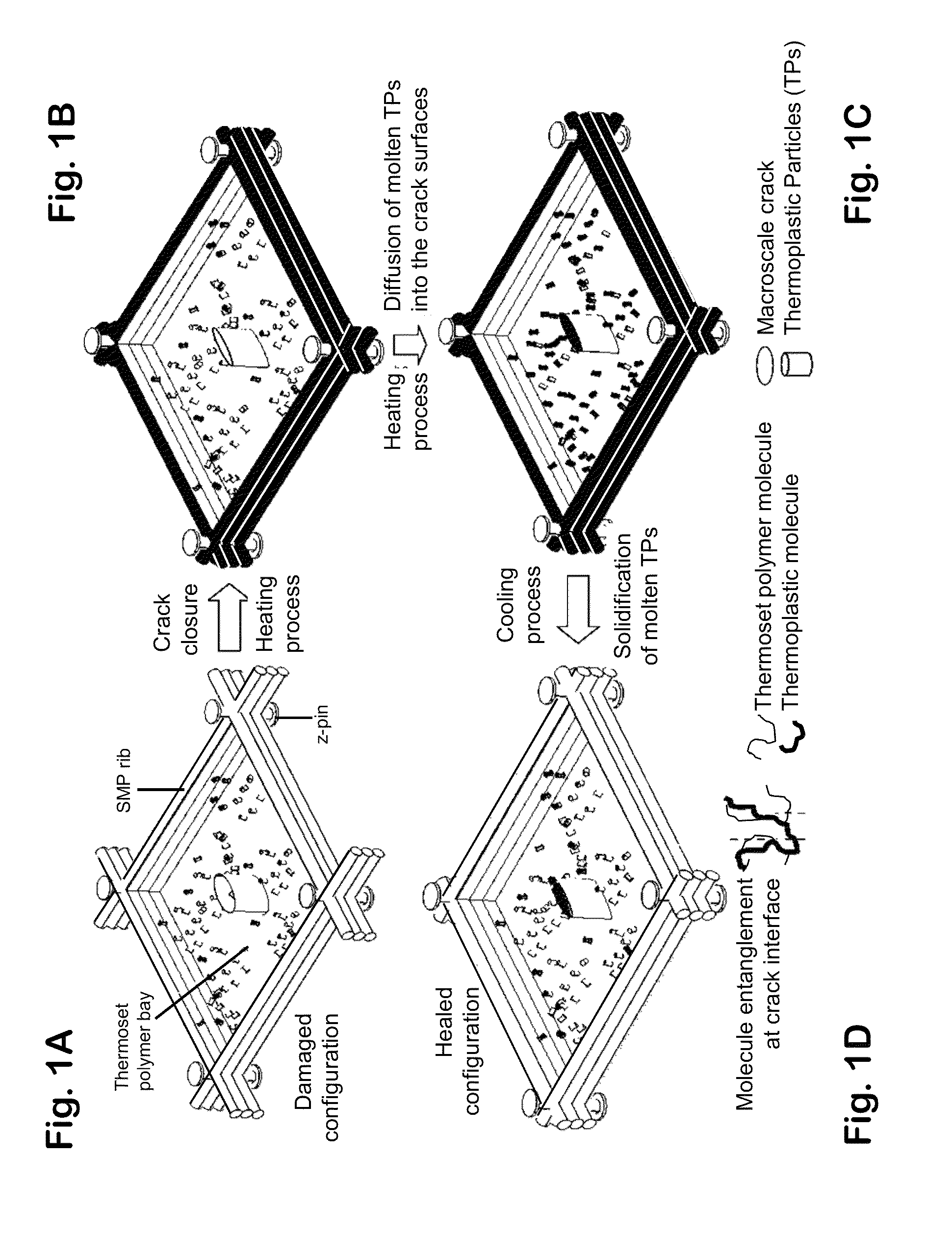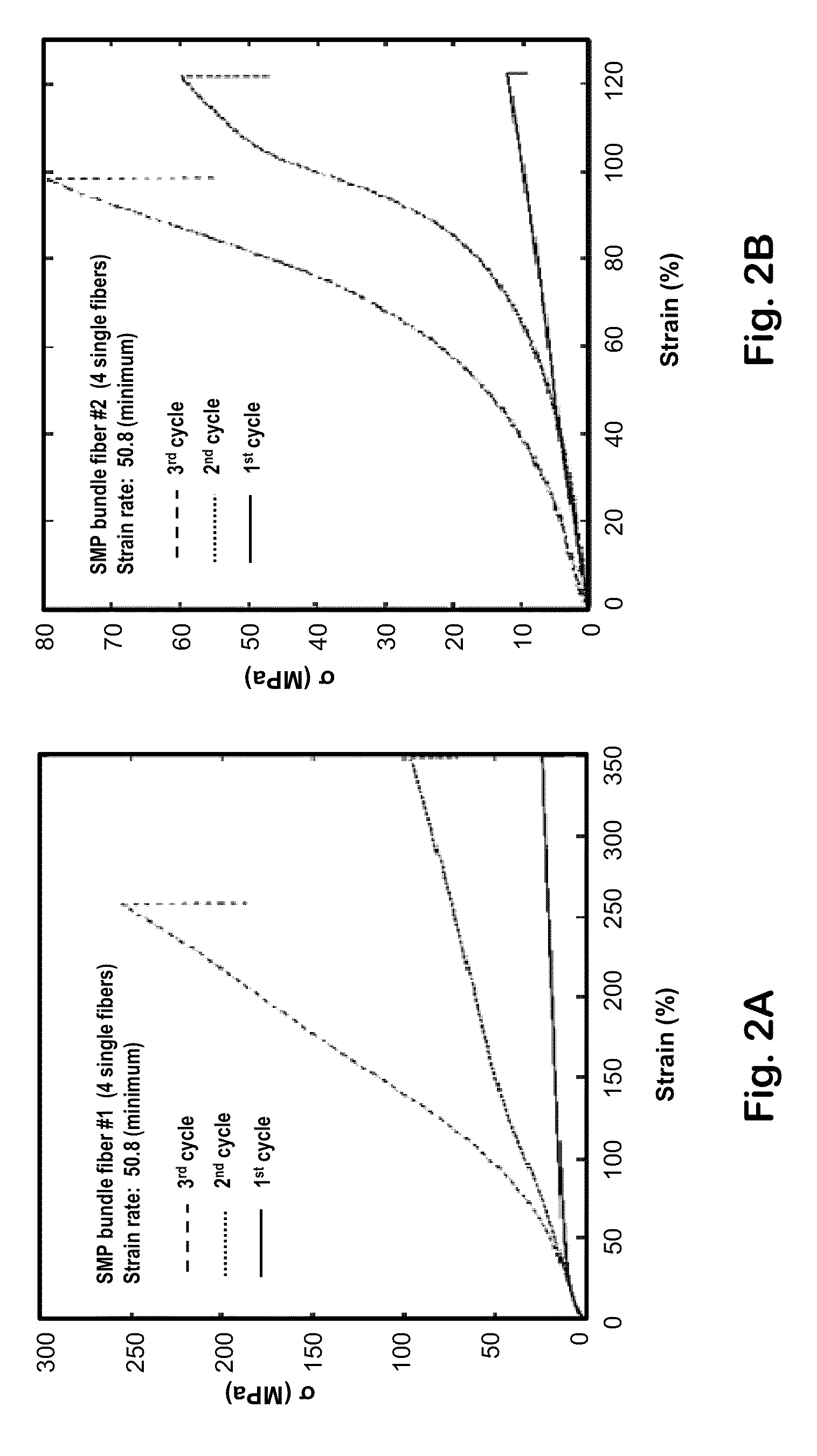Self-healing composite of thermoset polymer and programmed super contraction fibers
a thermoset polymer and super contraction technology, applied in the field of polymer materials, can solve the problems of affecting the performance of thermosets, the inability to re-form thermosets, and the inability to melt and re-form thermosets, and achieve the effects of excellent impact tolerance, light weight, and desired structural strength
- Summary
- Abstract
- Description
- Claims
- Application Information
AI Technical Summary
Benefits of technology
Problems solved by technology
Method used
Image
Examples
example 1
[0151]The following Example 1 is based on studies and data also set forth in: Guoqiang Li and Amir Shojaei, “A Viscoplastic Theory of Shape Memory Polymer Fibres With Application To Self-Healing Materials”, Proc. R. Soc. A (2012) 468, 2319-2346; this document is fully incorporated by reference herein.
[0152]In order to repeatedly and molecularly heal macroscopic cracks in conventional thermoset polymers, we here set forth a new bio-mimetic scheme that involves use of strain hardened, cold drawn SMP fibers that are used to create a z-pinned grid. Within the grid is placed conventional thermoset material. Thus, in this embodiment a SMP fiber z-pinned, continuous SMP fiber reinforced polymer grid skeleton that is filled in with conventional thermosetting polymer which comprises dispersed thermoplastic particles; see a unit cell representation in FIG. 1. This proposed composite will work similar to the two-step healing of human skin: close then heal (CTH), i.e., close the wound by bleedi...
example 2
[0179]The following Example 2 is based on studies and data also set forth in: Amir Shojaei, Guoqiang Li, George Z. Voyiadjis; “Cyclic Viscoplastic-Viscodamage Analysis of Shape Memory Polymers Fibres with Application to Self-Healing Smart Materials”, Journal of Applied Mechanics (January 2013), Vol. 80, 011014-1 through 011014-15; this document is fully incorporated by reference herein.
[0180]Cold-drawn programmed Shape Memory Polymer (SMP) fibres show excellent stress recovery property, which promotes their application as mechanical actuators in smart material systems. A full understanding of the thermomechanical-damage responses of these fibres is useful in order to minimize the trial-and-error manufacturing processes of these material systems. In this Example, a multiscale viscoplastic-viscodamage theory is developed to predict the cyclic mechanical responses of SMP fibres. The viscoplastic theory set forth is based on the governing relations for each of the individual micro-const...
example 3
[0187]The following Example 3 is based on studies and data also set forth in: Guoqiang Li, Harper Meng and Jinlian Hu, “Healable Thermoset Polymer Composite Embedded With Stimuli-Responsive Fibres”, J. R. Soc. Interface (2012) 9, 3279-3287; this document is fully incorporated by reference herein.
[0188]In this Example, a thermal-responsive fiber (e.g., stimuli-responsive fiber ‘SRF’ or SMP fiber) with outstanding mechanical properties and super contraction capability was fabricated for the purpose of healing macroscopic damages in thermoset polymer compositions. The SMP fibers and thermoplastic particles were incorporated into regular thermosetting epoxy for repeatedly healing macroscopic damages. The system works by mimicking self-healing of biological systems such as human skin, where a wound us first closed (e.g., by a stitch) thereafter the wound is healed. In the present context of thermoset polymer composites of the invention, a damage is closed through the thermal-induced supe...
PUM
| Property | Measurement | Unit |
|---|---|---|
| bonding temperature | aaaaa | aaaaa |
| toughness | aaaaa | aaaaa |
| toughness | aaaaa | aaaaa |
Abstract
Description
Claims
Application Information
 Login to View More
Login to View More - R&D
- Intellectual Property
- Life Sciences
- Materials
- Tech Scout
- Unparalleled Data Quality
- Higher Quality Content
- 60% Fewer Hallucinations
Browse by: Latest US Patents, China's latest patents, Technical Efficacy Thesaurus, Application Domain, Technology Topic, Popular Technical Reports.
© 2025 PatSnap. All rights reserved.Legal|Privacy policy|Modern Slavery Act Transparency Statement|Sitemap|About US| Contact US: help@patsnap.com



